Abstract
Keywords: Crops, efficiency, рotencial, recourse, region
Introduction
Colza are a raw material source for the production of vegetable oil, which can serve as a full-fledged substitute for sunflower oil deficiency. In many agricultural organizations, rapeseed has become a high-margin industrial crop, occupying at least one field in the crop rotation. At the same time, some important technical, technological, organizational and economic features of growing and harvesting rapeseed for seeds have not been worked out and mastered everywhere. In such cases, any acceptable performance indicators for the manufacture and rummage sale of products are not achieved (Shundalov, 2015). The economic situation naturally pushes Siberian farmers to diversify their crops. The search for the most cost-effective crops that are in demand on the market not only in Siberia, but also in other regions of Russia, neighboring countries has been going on for more than a year. One of these crops can rightly be called rapeseed.
Problem Statement
The purpose of this study is to study the experience of colza cultivation and determine the possibilities for expanding its production in the Altai Territory, which is an agrarian-oriented region.
Research Questions
The achievement of the set goal is determined by the fulfillment of a number of tasks in the course of the study:
- study of the characteristics of rapeseed cultivation;
- determination of its commercial properties and possibilities of their application; assessment of the level of development of production and processing of rapeseed in the Russian Federation, the Siberian Federal District and the Altai Territory;
- identifying prospects associated with the expansion of rapeseed production in an agrarian-oriented region.
Purpose of the Study
The work was done using economic-statistical, analytical methods and techniques. Among them, one should indicate: monographic and dialectical research methods, vertical and horizontal analysis, calculation of absolute and relative indicators, comparison, graphical reflection of the results obtained and logical conclusions. The main analytical base of the study was the information resources and statistical collections of Russia, the Altai Territory, news agencies, sectoral ministries and departments, in particular the data of the Ministry of Agriculture of Russia and the Altai Territory, open printed works on the topic being developed.
Research Methods
The history of rapeseed cultivation in our country goes back to the mists of time. There is historical evidence that this crop was cultivated in the Russian Empire in the period beforehand previous and very successfully. By the end of the 19th century, the area of rapeseed in our country reached 350 thousand hectares. At that time, oil was used for lubrication and as a fuel for street lamps, and bagasse with a high content of glycosylates was used as a fertilizer in field crops. However, the discovery and introduction of mineral fuels and oils led to a reduction in the area under rapeseed. Currently, rapeseed has again become one of the main oilseeds cultivated in Russia along with sunflower and soybeans, which is not surprising, because it is one of the wildest rising oil-rich seed, together in the biosphere and in the Russian Federation (Voronkova & Kovaleva, 2019).
Until now, rapeseed in the Russian Federation is an export-oriented crop and the main consumers of commercial rapeseed and its products are the EU countries, and recently China. In Germany, for the last couple of years, rapeseed oil has taken the first place in terms of its consumption among all vegetable oils. In the same place, technical oil is effectively used as an additive to diesel fuel. Every liter of diesel offered at gas stations currently contains 7.5% rapeseed oil. This figure was planned to be increased to 12 percent by 2020, but due to the situation on the oil market and environmental problems, this program has been “frozen” for the time being (Fedulova et al., 2019).
The widespread use of rapeseed in Russia began in 2000. «…Numerous market studies, publications and periodicals indicate that the interest in rapeseed among Russian agricultural producers is growing every year. First of all, because oilseeds are more profitable than grains. In the last two or three years, prices for rapeseed have been higher than for sunflower. To a greater extent, agricultural production is expanding at the expense of the Asian part of Russia - Siberia. Rapeseed is one of the few oilseeds that can guarantee a mature seed yield in areas with a relatively short growing season. This contributes to its advancement to the more northern regions of the Siberian region, thereby increasing the area of cultivation» (Chepeleva & Shmeleva, 2019).
In recent years, commercial interest in rapeseed has increased dramatically in Russia. This oilseed crop proved to be not only highly profitable, but also multifaceted. Today, oil for cosmetology, pharmacology and cooking, biodiesel, meal, cake and green mass for livestock feed are obtained from rapeseed. It is also used as green manure, a crop used to clear land from radioactive elements and to “pull out” minerals inaccessible to other crops into the upper layers of the soil (Shevchuk & Slyusareva, 2021; Voronkova & Kovaleva, 2019).
Rapeseed production is constantly increasing. It occupies about 9-12% of the total oilseed area in the world. The main regions for the production of rapeseed: Asia - 46.8% of world production, Europe - 30.3%, North America - 19.2%.
In recent years, the production of this crop in Russia has also increased significantly. According to the Federal State Statistics Service, the sown areas of winter rapeseed in our country doubled from 2007 to 2020 (from 150.2 thousand hectares to 307.3 thousand hectares). If in 2011 the total area of cultivation of both spring and winter rapeseed was 894 thousand hectares, then in 2021 it has already reached 1.68 million hectares. The gross volume of production of spring and winter rapeseed has actually increased by 3 times. Interestingly, over the past decade, the cultivation regions have shifted from Central Russia to Western Siberia and the Volga region. In recent years, the leaders in rapeseed areas have been the Altai and Krasnoyarsk Territories, the Omsk Region, the Republic of Tatarstan, the Novosibirsk, Kemerovo, Tula, Ryazan, Lipetsk Regions and the Republic of Bashkortostan, the director of the All-Russian Research Institute of Rapeseed comments (Voronkova & Kovaleva, 2019). Rapeseed is becoming increasingly popular among agricultural producers due to its high marginality and the ability to sow in the fall and harvest in the summer, which allows increasing the share of winter crops in the crop rotation. Winter rapeseed is more productive than spring rapeseed due to the possibility of obtaining moisture from the soil in the spring. Spring rapeseed is more often exposed to drought in summer, so its yield is lower than that of winter rapeseed. As for the areas occupied by this crop, most of them fall on spring rapeseed (Krapchina & Kotova, 2014; Shevchuk & Slyusareva, 2021).
In Russia, prices for rapeseed for processing, as well as for seeds of other agricultural crops, as well as grain, are quite volatile. Thus, the average price of rapeseed seeds in Russia in November 2020 was set at 30.5 thousand rubles / t, exceeding the price of November 2019 by 1.38 times. At the same time, the highest price for rapeseed was recorded in the Central Federal District, where they were sold for 33.2 thousand rubles per ton. At the same time, in the Volga Federal District, rapeseed seeds were the cheapest - 26.2 thousand rubles / t. In 2021, the price of seeds of this crop rose even higher: in September 2021, the oil extraction plants of the Lipetsk region purchased rapeseed seeds at a price of 53-54 thousand rubles/t with an oil content of 46% or more (Voronkova & Kovaleva, 2019).
In total, in the Siberian Federal District, 20% more agricultural land was sown with rapeseed in 2020 than in 2019. In 2020, Siberian farmers harvested 908.9 thousand tons of rapeseed, which is 32% higher than in 2019. To date, the share of the Siberian Federal District in the total volume of harvested grain in Russia has reached 35%. According to experts, not only grain collection will grow, but also its processing in the district. The popularity of this crop is explained by high profitability and prospects for export to Asian countries (Krapchina & Kotova, 2014).
According to Russtat, the sown area for rapeseed in the Siberian Federal District in 2020 amounted to 567.9 thousand hectares, which is 16.5% less, or 112.4 thousand hectares, compared to 2019. At the same time, in 2020, the agricultural enterprises of the district harvested 31.5% more than in 2019 - a total of 908.9 thousand tons of rapeseed (35% of the volume of harvested rapeseed in Russia). The yield increased from 11 c/ha to 16 c/ha, or by 48%. “This is the most significant growth among the districts of Russia,” noted the Siberian District Information Center (Krapchina & Kotova, 2014).
According to the latest data from the Ministry of Agriculture of Russia, according to the results of spring field work in 2021, rapeseed was sown in Siberia by 15.7% more than planned and by 20% than in 2020 - a total of 682.5 thousand hectares (49.4% of the rapeseed sown area across Russia). The leaders in terms of sown area are the Altai and Krasnoyarsk Territories, as well as the Novosibirsk Region. In these regions, in 2021, the sown area for rapeseed increased: in the Altai Territory by 22%, in the Krasnoyarsk Territory by 39%, in the Novosibirsk Region by 26%. In the current season, the department predicts a record crop harvest - 2.8 million tons against 2.5 million tons last year (Krapchina & Kotova, 2014; Voronkova & Kovaleva, 2021). In 2019, the Altai Territory became the leader among Russian regions in terms of rapeseed acreage with an indicator of 184.5 thousand hectares, which is 11.8% of the total Russian area. In 2019, 86 thousand hectares, or 46% of the area occupied by rapeseed, were harvested in the Altai Territory. The yield fell compared to last year and amounted to 10-10.4 c/ha.
It should be noted that the quality of rapeseed grown in Russia is highly valued on the world market. So, China is showing great interest in it. Chinese companies are ready to pay for this crop when it is still in the vine (Krapchina & Kotova, 2014). In 2020, the Altai Territory, being an agrarian-oriented region, ranked second among the regions of Russia in the production of rapeseed (189.000 tons) in Figure 1, 2.
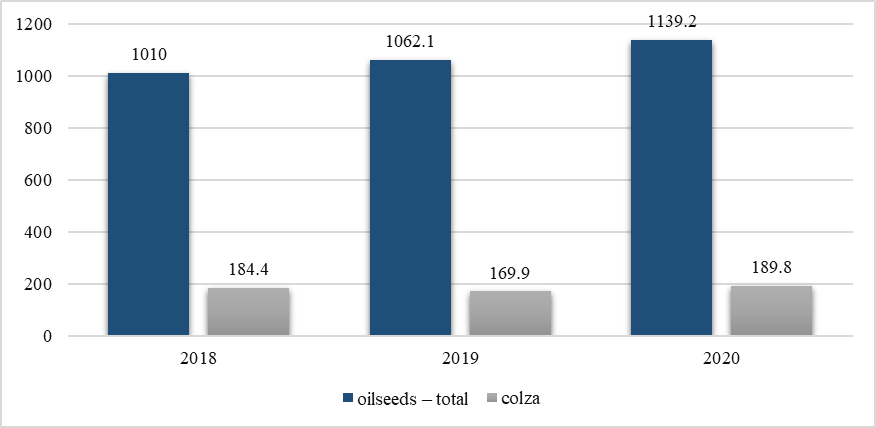
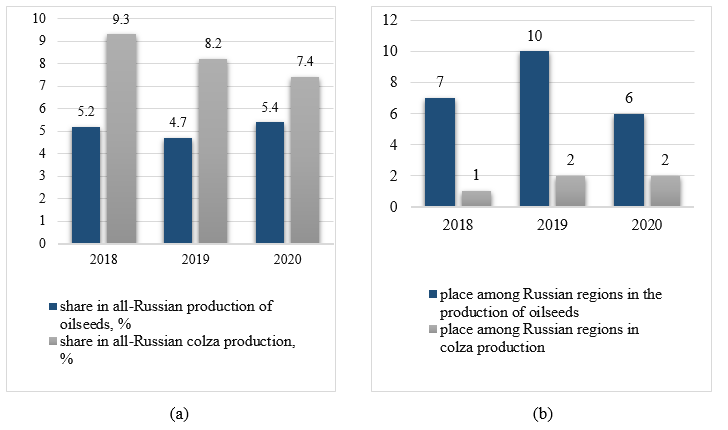
In 2020, a decent harvest of rapeseed was obtained in the Altai Territory - 189.8 thousand tons were harvested (in weight after processing), which exceeds the average five-year value by 1.1 times in Figure 3.
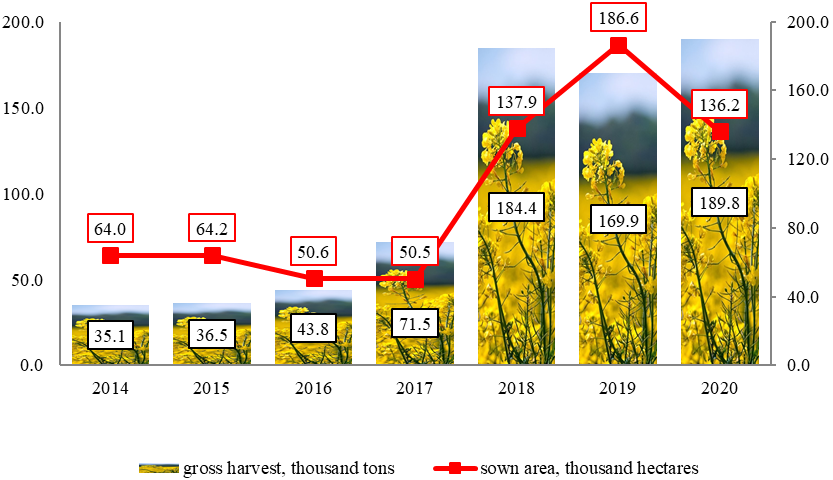
Today, SibAgroCentre offers farmers several varieties of rapeseed that have proven themselves well. This is a well-known variety Jubilee and new varieties - Amulet and Ruyan. The varieties Region 55 and Kupol will also remain in the assortment (Voronkova & Kovaleva, 2021).
Variety Yubileiny was bred by breeders of the Siberian Experimental Station VNIIMK. It is distinguished by friendly seedlings, is resistant to drought, disease damage and consistently shows good results. In terms of yield, it surpasses imported hybrids and is much more attractive in price (Voronkova & Kovaleva, 2021).
The novelties of Russian seed production are the early maturing variety Ruyan and the early maturing variety Amulet, which also demonstrate high productivity.Variety yield Ruyan is due to its ability to form additional stems. Due to the greater number of stems, more pods are formed and the yield increases. As a result, farmers can get both a lot of seeds and a lot of green mass. Moreover, the variety shows stable results in various soil and climatic conditions (Voronkova & Kovaleva, 2021; Chepeleva & Ovsyanko, 2019).
Variety Amulet is distinguished by high quality oil. The high content of oleic acid (76-78%) improves its nutritional and taste properties. High-oleic rapeseed oil is similar in properties to olive oil and is characterized by increased oxy- and thermal stability.
The long-term use of these varieties confirms their stability and competitive advantages over most foreign hybrids. Thanks to these indicators, the demand for commercial rapeseed will grow. This year, these varieties also surpassed imported competitors in yield (Voronkova & Kovaleva, 2021).
As already noted, oilseeds are among the most profitable crops. The cost of growing 1 hectare of rapeseed in 2020 compared to 2019 amounted to 137.2% in Figure 4.
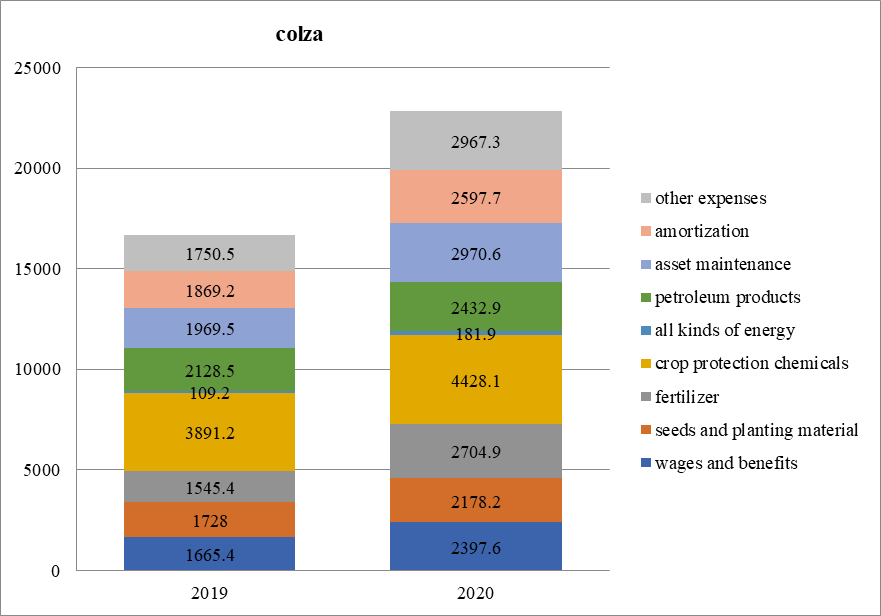
In 2020, the cost of fertilizers for rapeseed increased by almost 1.8 times. In the cost structure of rapeseed, the largest share (19.4%) belongs to plant protection products. The dynamics of the economic efficiency of rapeseed production is presented in Table 1.
Stabilization of the price situation in the crop production market in the Altai Territory led to an increase in the selling price of rapeseed. In 2020, compared to 2019, the price increased by 44.6%. The profitability of rapeseed in 2020 reached 77.9% ($not-found(+58.3 percentage points compared to 2019)58.3 percentage points compared to 2019).
It should be noted that rapeseed is a largely export-oriented crop. So, in 2020, in the Altai Territory, the export of rapeseed oil amounted to 23.5 thousand tons in the amount of 21.5 million dollars (Nosov et al., 2020).
Rape culture is multifaceted. However, in addition to the obvious economic advantages, it has environmental and agro technical advantages. Thus, one hectare of well-developed shoots of winter rape releases 10-11 million liters of oxygen into the atmosphere, second only to sugar beet. Another plus is related to the fact that rapeseed is an excellent means of recultivating radioactive contamination of soils. At the same time, only an extremely small part of heavy metals gets into the seeds: everything “harmful” settles in the green part. Or take another direction - rapeseed for biodiesel. For comparison, one liter of diesel fuel emits 3 kg of CO2 into the atmosphere, and a liter of biodiesel emits 0.5 kg. In addition, 1 ha of rape during the growing season absorbs 22 tons of CO2, which are formed when 6.5-7 tons of diesel oil are burned. But the most important, in our opinion, is that 2.25 times more energy is accumulated in rape seeds than is spent on its production. For sugar beets, this figure is 1.63, for corn - 1.28, for wheat - 1.14, for potatoes - 1.04. It turns out that this culture accumulates the energy of the sun better than others (Voronkova & Kovaleva, 2019).
In order to get a high margin, it is important to follow the cultivation technology, and rapeseed is not the easiest crop in this regard. Thus, winter rapeseed is very sensitive to violations in growing technology. The culture should go into winter in the phase of 8-10 leaves, with a root collar with a diameter of 8 mm, and for this it is necessary to comply with a number of mandatory requirements, without which it is difficult to achieve such a result. For example, it is impossible to sow winter rapeseed on over compacted soils, since it needs to form a strong and deep root system for successful growth, development and overwintering (Chepeleva & Ovsyanko, 2019).
Canola grows best in soils with a pH level close to neutral. If the soil is highly acidic, then bacterial rot can appear on rapeseed. And in the flowering phase, rapeseed is exposed to harmful insects (rapeseed beetle, cruciferous flea and cruciferous moth), which significantly reduce yields (Nurlygayanov & Karoma, 2016).
In Siberia, in 2020, companies produced 106.2 thousand tons of products (which is 15% more than in 2019), or 17% of the total oil produced in Russia. The leaders in this segment are the enterprises of the Altai Territory and the Omsk Region, which account for 32.6% and 34.4%, respectively, of the total volume of butter produced (Brechko & Cheplyanskaya, 2020; Krapchina & Kotova, 2014).
In 2021, experts also predict an increase in rapeseed oil production in the district. Thus, at the plants of the Altai Territory and Omsk, which is one of the largest producers of rapeseed oil in Siberia, the Blago group of companies produced 35.7 thousand tons of rapeseed oil in the first half of 2021. While for the whole of 2020 this figure was 14 thousand tons, in 2019 it was 21 thousand tons. A significant increase in production was caused by an increase in export shipments. China has become the main buyer of bulk oils.
In total, in the Siberian Federal District, according to Rosstat, 43 enterprises produce rapeseed oil. This is the maximum number among all districts. In total, there are 104 such enterprises in the Russian Federation, of which 22 are located in the Altai Territory (Voronkova & Kovaleva, 2021).
In addition to rapeseed oil, Russia also exports rapeseed. The main exporter of this resource in the Russian Federation is the Siberian Federal District in Figure 5. It accounts for 56% of total exports.
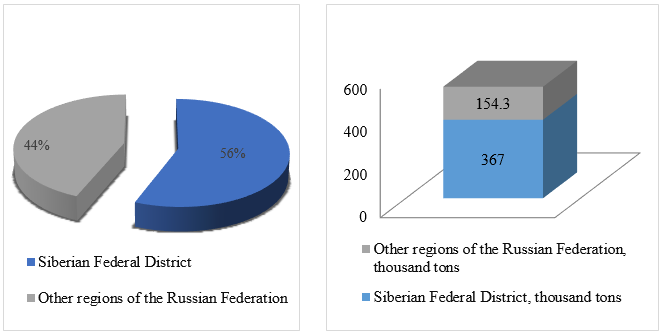
Assessing the contribution of individual regions of the Siberian Federal District to the total volume of exports, the Novosibirsk Region and the Altai Territory should be noted. Their total contribution is about 63% in Figure 6.
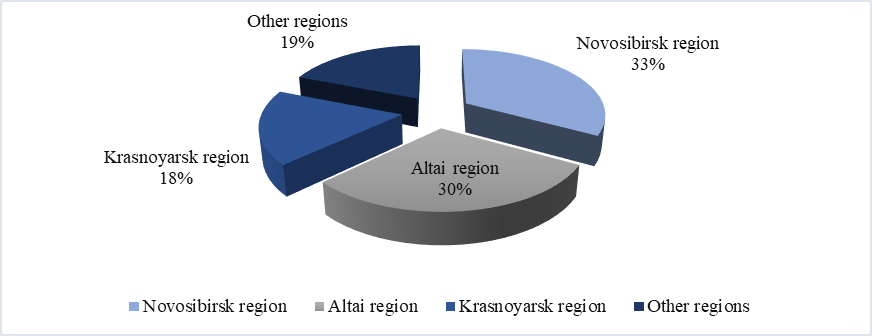
Findings
Altai Territory, using its potential, produces about 40% of agricultural products with improved environmental characteristics. The issues with low rates of modernization and technical re-equipment of the industry remain unresolved; lack of financial resources; low level of raw materials processing; underdevelopment of the logistics infrastructure; low rates of development of inter-farm and sectoral cooperation and integration, internal migration processes associated with the outflow of the rural population and the predominance of the population of retirement age. Thus, is of increasing strategic importance both for the environment and for refining the excellence of lifetime of the people.
Conclusions
Based on the analysis of the state of the industry, assessment of the oilseeds market, we consider it expedient to further develop the production and processing of rapeseed crops in the Altai Territory.
Being an agrarian-oriented region, the region has all the opportunities for the successful implementation of this activity. Currently, most of the rapeseed produced in the region is exported, because without access to overseas marketplaces, new manufacture will not pay off soon, and selling it on the domestic market is an unrealistic task. Thanks to the right strategy of gradual market development, Altai rapeseed producers and processors will be able to pave the way for interaction with end consumers and conduct productive negotiations.
References
Brechko, Y., & Cheplyanskaya N. M (2020). Vozdelyvanie rapsa v Respublike Belarus': pokazateli i faktory effektivnosti [Rapeseed cultivation in the Republic of Belarus: indicators and efficiency factors]. Sustainable socio-economic development of regions: materials of the International scientific and practical conference dedicated to the 95th anniversary of the department economics and international economic relations in the agro-industrial complex. Belarusian State Agricultural Academy. https://baa.by/upload/ek/sbornik1.pdf
Chepeleva, K. V., & Ovsyanko, L. A. (2019). Raps na eksport - novye vozmozhnosti apk krasnoyarskogo kraya [Rapeseed for export - new opportunities of the agricultural industry of the krasnoyarsk region]. Materials of the international scientific conference “Problems of modern agrarian science", 308-313. https://elibrary.ru/item.asp?id=41289550
Chepeleva, K. V., & Shmeleva Zh. N. (2019). Production and processing of oilseed crops – a strategic agro-industrial complex development vector of the Krasnoyarsk territory. IOP Conference Series: Earth and Environmental Science, 315(2), 022053.
Fedulova, I., Voronkova, O., Zhuravlev, P., Gerasimov, E., Glyzina, M., & Alekhina, N. (2019). Labor productivity and its role in the sustainable development of economy: on the example of a region. Entrepreneurship and Sustainability Issues, 7(2), 1059-1073.
Kovaleva, I., Kudinova, M., Levichev, V., Ghidkich, E., & Shevchuk, N. (2021). Development of rural territories of the agro-oriented region in the conditions of self-sufficient food supply. IOP Conf. Series: Earth and Environmental Science, 839 022019.
Krapchina, L. N., & Kotova, L. G. (2014). Prodovol'stvennaya bezopasnost' v usloviyah globalizacii: puti sohraneniya i povysheniya [Food security in the context of globalization: ways to preserve and improve]. Food policy and security, 1(1), 53-66.
Malakhov, A. V., & Khorunzhin, M. G. (2018). Ekonomicheskie predposylki proizvodstva rapsa v rossii i altajskom krae [Economic prerequisites for rapse production in russia and altai krai]. Agrarian science - agriculture: collection of materials of the XIII International Scientific and Practical Conference. Barnaul: Altai State Agricultural University. https://elibrary.ru/item.asp?id=32702406
Nosov, V. V., Suray, N. M., Mamaev, O. A., Chemisenko, Panov, P. A., & Pokidov, M. G. (2020). Milk production dynamics in the Russian Federation: causes and consequences. IOP Conf. Series: Earth and Environmental Science, 548, 022091.
Nurlygayanov, R. B., & Karoma A. N. (2016). Ocenka ekonomicheskoj effektivnosti tekhnologii vozdelyvaniya semyan yarovogo rapsa v zapadnoj sibiri [Evaluation of the economic efficiency of the technology of cultivation of spring rape seeds in western Siberia]. Nikon Readings, 21, 121-122. https://www.elibrary.ru/item.asp?id=27180508
Shevchuk, N. A., & Slyusareva A. E. (2021). Problemy prodovol'stvennogo obespecheniya altajskogo kraya [Problems of food supply of the altai territory]. Agrarian science - agriculture: Collection of materials of the XVI International Scientific and Practical Conference, 2. Barnaul: Altai State Agricultural University. https://elibrary.ru/item.asp?id=46118237
Shundalov, B. M. (2015). Ekonomicheskaya effektivnost' proizvodstva rapsa [Economic efficiency of rapse production] Bulletin of the Belarusian state agricultural academy, 3, 5-9. Belarusian state agricultural academy). https://elibrary.ru/item.asp?id=29808319
Voronkova, O. Y., & Kovaleva, I. V. (2019). Resource Potential and Production Efficiency High-Quality Organic Products in Russia. QUALITY Access to Success, 20(172), 14-117. https://www.elibrary.ru/item.asp?id=41648950
Voronkova, O., & Kovaleva, I. (2021). Ecological Consequences of the Intensification of Agricultural Production and Land and Agrarian Reforms (Based on Materials from the Altai Territory). IOP Conf. Series: Materials Science and Engineering, 1079, 072007.
Copyright information

This work is licensed under a Creative Commons Attribution-NonCommercial-NoDerivatives 4.0 International License.
About this article
Publication Date
29 August 2022
Article Doi
eBook ISBN
978-1-80296-126-3
Publisher
European Publisher
Volume
127
Print ISBN (optional)
-
Edition Number
1st Edition
Pages
1-496
Subjects
Economics, social trends, sustainability, modern society, behavioural sciences, education
Cite this article as:
Kovaleva, I. V., Kudinova, M. G., Shevchuk, N. A., & Elistratova, T. G. (2022). Economic Efficiency Use Recourse Of Potencial In The High-Intensity Crops. In I. Kovalev, & A. Voroshilova (Eds.), Economic and Social Trends for Sustainability of Modern Society (ICEST-III 2022), vol 127. European Proceedings of Social and Behavioural Sciences (pp. 288-298). European Publisher. https://doi.org/10.15405/epsbs.2022.08.33

